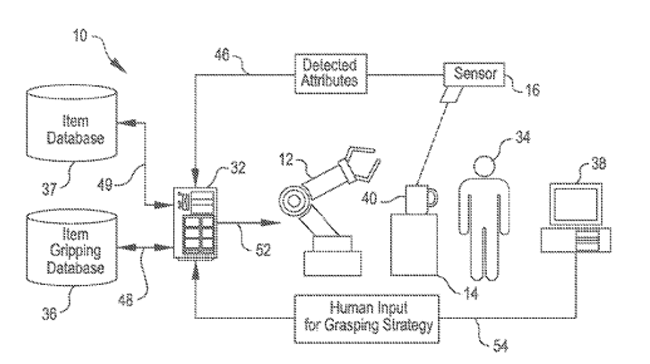Another week, another supply chain-related patent received by Amazon.com. Recent patents have included an idea for dropping packages from flying drones using parachutes (described below), and earlier for a blimp serving as a mobile, airborne distribution center.
This week, we report on a recent Amazon patent is for a complex system using robotic arms to pack goods into shipping cartons in combination with human operators.
The patent filing is complex, but we will cover the highlights here.
Supply Chain Digest Says... |
|
|
The patent describes how robotic arms or manipulators will controlled in a way that grasps items after they have been picked by a human in the manner best suited for grasping of each item. The grasping strategy could be determined based on data from optical or other sensors, and/or from information in a database about the item's characteristics.
That database could also hold "information indicating grasping strategies that have been successful or unsuccessful for such items in the past," the patent states. (See figure from the patent filing below).
One example of this concept, the patent says, would involve a robotic arm positioned within reach of a tray. A human operator loads the tray with an inventory item (for example a coffee mug) that is to be grasped by the robotic arm and moved into the appropriate shipping carton stored say in a cart with other cartons.
The mug in the tray would be identified according to a unique identifier number, such as by a scanned bar code or radio frequency identification tag. The unique identifier of the mug would be used to access a record about the mug from an item database to determine its weight and a stored digital model representing the shape of the mug.
A camera or other optical imaging device would then be used to scan the mug, providing information about the mug's orientation, such as say that in this case the mug is on its side with the open top facing the camera and the handle to the right.
Amazon's New Patented System for Robotic Order Packing

The weight, shape, and orientation of the mug are collectively used to query a grasping strategy database for the optimal strategy appropriate for this grasp.
That may lead to the system determining in this specific case that it is best to approach the mug from the open top to grasp the mug on its bottom, using 60% of the robotic arm's suction capacity, and to rotate while moving toward the target box so that the mug is set down with the bottom facing down and the handle aligned in the foam slot specially formed in the left side of the box to receive the handle.
Wow, that is a smart robot.
(See More Below)
|
CATEGORY SPONSOR: SOFTEON |
|
|
| |
|
|
What if there are no available strategies are available for a particular item?
A new grasping strategies may be generated. For example, grasping strategies for similar items (such as, other mugs) may be accessed and/or adapted to provide a grasping strategy for the mug presented to the robotic arm.
Alternatively, the human operator may provide input about how the mug may be effectively grasped by the robotic arm, such as by selecting from different options presented on a screen or by donning a glove and grasping the mug so that a grasping strategy for the robotic arm may be generated using information from features on the glove (e.g., pressure sensors, tactile sensors, or fiducial markers used to track the motion of the glove with an optical imaging device).
More wow.
One major question: Does this patent prevent others from developing smart grabbers using the types of data Amazon references in the patent?
As many know, Amazon has conducted a robotic picking contest in each of the past two years, featuring teams from around the world competing to see which technology can best select an oddball assortment of goods from static shelving and placing them into a tote.
As SCDigest reported last year, there was substantial progress in the ability of the robots to select the items and especially how long it took in the second contest versus the first one in 2015. (See Great Progress Made in Amazon's Second Robotic Picking Challenge.)
Another Patent for Drone Deliveries
As mentioned above, Amazon was also recently awarded a patent for a method to guide packages released from drones safely to the ground.
The patent says Amazon is considering keeping its drones high above customers' homes, an approach that could be more efficient and safe.
In the document, Amazon said that landing a drone takes more time and energy than releasing a package from high in the sky. If Amazon's drones don't land in yards, this would also prevent potentially dangerous collisions between the drones and any people, pets or objects in a customer's yard.
The patent also describes how Amazon's drones would use magnets, parachutes or spring coils to release the delivery while in mid-flight. Once the package is released, the drone would then monitor the descending box to make sure it's dropping properly onto the desired landing patch.
For example, wind could potentially blow a package into a balcony, power line or tree. To solve this, Amazon's drones would radio a message to an off-course package, instructing it to deploy a parachute, compressed air canister or landing flap.
Actually, competitors such as Google have shown off similar plans, in which a package is dropped from the sky.
Will this or any of Amazon's other drone delivery plans ever, um, take off? Right now of course they can't even really test the things in the US, given current FAA rules. But SCDigest believe that will have to change, given global competition for drone development
What is your take on Amazon's patent for the smart packing robots? Let us know your thoughts at the Feedback section below or the link above to send an email.
Your Comments/Feedback
|